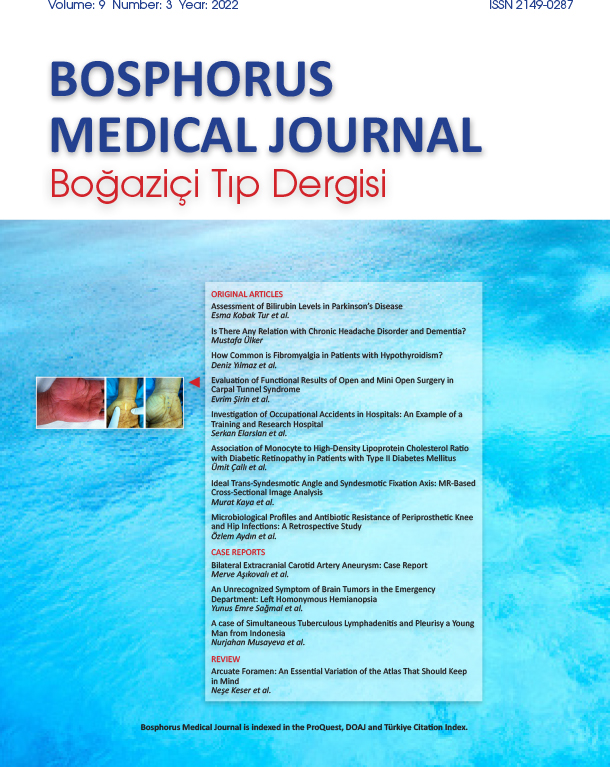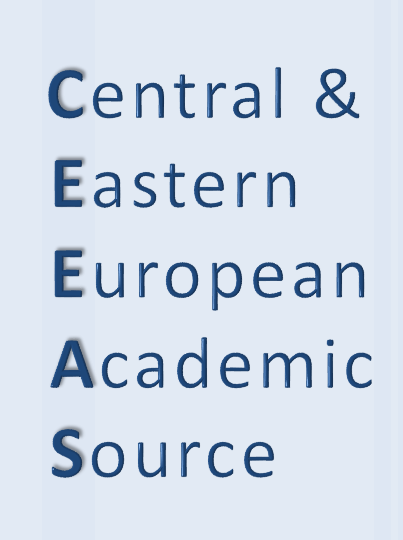Volume: 3 Issue: 1 - 2016
| ORIGINAL RESEARCH | |
| 1. | Ocular Vestibular Evoked Myogenic Potentials in Patients with Multiple Sclerosis Eren Gözke, Zeliha Baştürk Ayhan, Nursel Erdal, Nurbanu Gürbüzer, Meryem Kaydan, Pelin Doğan Ak Pages 1 - 4 INTRODUCTION: Vestibular evoked myogenic potential (VEMP) test is a technique based on activation of vestibular apparatus by acoustic stimulation. In this study we aimed to investigate the presence of vestibulopathy in patients with relapsing remitting multiple sclerosis (RRMS) who have not vestibular complaints using ocular VEMP (oVEMP) test. METHODS: Forty patients diagnosed as RRMS according to revised McDonald criteria and 30 healthy controls were enrolled in the study. oVEMP tests were performed through contralateral inferior oblique muscles. Active electrode was placed on the lower eyelid, and the reference electrode was attached 1cm below. The patients were requested to stare towards a superolateral direction so as to activate inferior oblique muscle. Meanwhile 120 dB click stimulation was delivered to the contralateral ear at 10/sec for 150 sec, and 1500 responses were averaged. The test was repeated twice for each side and the latencies and amplitudes of the initial negative (N1) and positive (P1) waves were measured. Availability of any response, their latencies and amplitudes were compared. RESULTS: Nine cases of RRMS (22.5 %) could not yield any response in both sides, while in the control group no bilateral response was obtained in 4 cases (13.3%). Also in RRMS group no unilateral response was obtained in 5 (12.5%) cases. In the RRMS group mean latencies of N1 and P1 were significantly longer, while N1-P1 amplitudes were found to be meaningfully lower. DISCUSSION AND CONCLUSION: These findings demonstrate that using oVEMP test subclinical vestibulopathy can be elicited in RRMS patients without vestibular complaints. |
| 2. | Infectious Complications of Transrectal Ultrasound-guided Prostate Needle Biopsy: A Retrospective Case-Control Study Fatih Uruç, Çağlar Yıldırım, Bekir Aras, Mithat Kıvrak, Aytaç Şahin, Serkan Akan, Özgür Haki Yüksel, Ahmet Ürkmez Pages 5 - 8 INTRODUCTION: Transrectal ultrasonography-guided prostate needle biopsy (TRUS-PB) is used as a standard procedure for the diagnosis of prostate cancer. TRUS-PH has serious complications, such as fever, urinary tract infections and sepsis. With the introduction of quinolones, the infectious complications after the prostate biopsy have decreased. Frequent and incorrect use of antibiotics has become an important problem for quinolone resistant infections.In this retrospective study we aimed to investigate datas of 685 patients underwent TRUS-PB and 16 patients required hospitalisation after biopsy due to enfectious complications between 2013-2015 under the light of literature. METHODS: RESULTS: DISCUSSION AND CONCLUSION: |
| 3. | Results of Minimally Augmented Bilateral Lateral Rectus Recessions in Intermittent Exotropia Yeşim Oral, Şu&776;lay Eraslan Özdil, Özlen Rodop Özgu&776;r, Işıl Sayman Muslubaş, Yelda Özkurt Pages 9 - 15 INTRODUCTION: To evaluate the results of surgical treatment in patients with intermittent exotropia METHODS: 127 intermittent exotropia (XT) patients which were diagnosed at Dr. Lutfi Kırdar Kartal Training and Research Hospital Eye Clinic between March 2003 to December 2010, were classified according to Kushner classification into seven groups were retrospectively reviewed and thirty-six of the intermittent XT patients with deviation of more than 20 prism diopters that underwent surgery were included to the study. We used recommended surgical dosages by Kushner. Only bilateral lateral rectus recessions were performed 0.5 mm more than standard amounts of ybilateral lateral rectus recessions. The surgical outcomes were assessed in the first week and 1 year after surgery. The outcome was considered successful within 10 PD of orthotropia after surgery. RESULTS: This study includes the results of 36 patients, 18 male and 18 female, who were operated for intermittent XT between the ages of 5 and 51 years old (mean 17.16±11.9). We performed symmetrical lateral rectus recessions in 28 patients (77.8%), unilateral recession and resection in 6 patients (16.6%) and 3 muscles surgery in 2 patients (5.6%). We applied recommended management based on Kushners surgical formula except that we performed 0.5 mm more lateral rectus recessions compared to recommended surgical dosages. Our success rate was 94.4% in the first week and 86.1% at the end of the one year postoperatively. DISCUSSION AND CONCLUSION: We achieved fairly good results in the intermittent XT surgery by using Kushner classification and minimally augmented surgical dosages for bilateral lateral rectus recessions. We think that identification of subgroups with careful examination, proper diagnosis and choosing a suitable surgical procedure provide superior results. |
| 4. | Checking Of Surface Cleaning In Intensive Care Unit Ceren Köksal, Güldem Turan, Nur Akgün, Arzu Yıldırım Ar, Celal Öztürk, Canan Ağalar Pages 16 - 21 INTRODUCTION: Our efforts to decrease intensive care infections has increased our awareness of environmental cleaning. Therefore, we started questioning the effectiveness of cleaning and started to monitor surface cleaning. In our 20 beds intensive care unit, 14 different objects those are frequently touched, and total 189 surface were marked during morning and evening shifts by using Fluorescent Marking Gel and monitored for remaining fluorescend marks after cleaning by using the ultraviolet light for two consecutive 6-day periods; first without the knowledge of cleaning staff and then after informing the cleaning staff. The clinical and statistical significance between the cleaning during the uninformed and informed periods revealed the necessity of implementing such a monitoring system. As a result, in order to monitor the effectiveness of in-service trainings, it is necessary to audit cleaning with a visible method. METHODS: RESULTS: DISCUSSION AND CONCLUSION: |
| 5. | Antibacterial Activity of Cinnamomum Zeylanicum Bark Against Escherichia Coli Isolates Birgül Kaçmaz, İlker Durak Pages 22 - 25 INTRODUCTION: The aim of this study was to investigate the antibacterial activity of Cinnamomum zeylanicum bark (Czb) water extract against Escherichia coli isolates. The synergistic activity of Czb water extract with various antimicrobial drugs against Escherichia coli isolates (extended spectrum beta lactamase-ESBL- producing and non-ESBL producing) was also investigated. METHODS: Isolates were isolated from various clinical specimens. Antibacterial activity of plant extract was determined by agar dilution method. The synergistic effect of Czb extract with certain antibiotics (ciprofloxacin, ofloxacin, ceftriaxone, amoxicillin-clavulonate, imipenem, amikacin, trimethoprim-sulfamethoxazole, piperacillin- tazobactam) was assayed by the disc diffusion method on agar containing subinhibitory concentrations of the extract. RESULTS: The extract showed antibacterial activity against all tested E. coli isolates. In non-ESBL producing isolates, the extract showed statistically significant synergism with all of the selected antibiotics. In ESBL producing isolates, significant synergism was detected only with imipenem. DISCUSSION AND CONCLUSION: In this study, in vitro Czb water extract was found to have antibacterial activity against E. coli isolates. Also, the extract was potentiated the antibacterial effects of the selected antibiotics. We thought that extract used in the study can contribute to the development of new antibacterial agents in the anti-E.coli isolates treatment regimen. |
| CASE REPORT | |
| 6. | Heparin Bounded E PTFE Graft for Long Segment Femoropopliteal Arterial Occlusive Disease: A Case Report Hüseyin Kuplay, Bülent Mert, Evren Müge Taşdemir Mete, Kamil Boyacıoğlu, Cihan Yücel, Murat Baştopçu, Vedat Erentuğ Pages 26 - 27 Percutaneous angioplasty and stenting is a favorable treatment of infrainguinal symptomatic atherosclerotic occlusive vessel disease for its low mortality and morbidity and as it can be reperformed if necessary. While standard treatment for long segment occlusive diseases of the superficial femoral (SFA) or popliteal artery such as TASC II type C and D is below-knee bypass with saphenous graft, recent developments in equipment and techniques have made balloon and stents another valuable option. ePTFE coated stents may increase patency rates in long segment femoropopliteal artery lesions. Furthermore we believe that extended ePTFE grafts are a good alternative as they allow implantation through an aboveknee incision for lesions that require a below-knee bypass where surgical exposure is more difficult. |
| 7. | Hypercalcemia-Related Acute Pancreatitis In A Chronic Hemodialysi̇s Patient: A Case Report Funda Türkmen, Ali Özdemir, Can Sevinç, Zeynep Yılmaz, Ferhan Aytuğ Pages 28 - 31 In patients who is on chronic hemodialysis treatment hypercalcemia can occur by various etiological factors. The most common cause is iatrogenic hypercalcemia. Acute pancreatitis is a rare complication of hypercalcemia. A 78-year-old diabetic female chronic hemodialysis patient had been admitted to our clinic with nausea, vomiting, confusion and abdominal pain complaints, had very high serum calcium level, and acute pancreatitis was diagnosed by clinical symptoms, high amylase and lipase levels and radiographic findings. That case is accepted as hypercalcemia-related acute pancreatitis. Risk of iatrogenic hypercalcemia is high in patients with chronic renal failure, but data concerned with hypercalcemia-related acute pancreatitis is very scant. Therefore, this case is worth of publication. |
| 8. | Treatment of Subclavian Steal Syndrome with Carotico-Subclavian Artery Bypass: A Rare Case Serkan Burç Deşer, Mustafa Kemal Demirağ Pages 32 - 34 Subclavian steal syndrome (SSS) is usually caused by unilateral subclavian artery (SA) occlusion or severe stenosis. Rarely seen bilaterally. Doppler ultrasonography (DUS) shows low antegrade blood flow of the right SA and retrograde flow of the left SA. Here we present a case of subclavian steal syndrome in a 49 year old woman who had dizziness and syncope following exercise treated with left carotico-subclavian artery bypass. |
| 9. | Sentetik Kanabinoid Entoksikasyonuna Bağlı Ağır Status Epileptikus Asu Özgültekin, Rabia Sarı, Sefa Gökten, Osman Ekinci Pages 35 - 39 Synthetic cannabinoids are easily synthesized in the laboratory environment and the unpredictable effects of the new product can show high toxicity on organ systems.The mechanism of effects are different, so that the standard medical therapies may not be effective leading to the serious clinical consequences. 25 years old male who has several admissions to the emergency department with the synthetic cannabinod usage and who had severe status epileptics that was not responded to the standard medical therapies was presented. The convulsions were lasted after about 20 hours leading to severe cerebral edema, and resulted with serious neurologic sequela. |
| REVIEW | |
| 10. | Surgical Approaches of Bilateral Abductor Vocal Cord Paralysis Arzu Tatlıpınar, Emrah Kınal Pages 40 - 45 Vocal cords are mostly in paramedian position in bilateral abductor vocal cord paralysis. Hence, the main problem of the patient is inspiratory dyspnea, due to obstruction at the level of glottis. The condition can be life threatening and surgical intervention can be required to prevent acute airway problem or pulmonary pathology due to chronic airway obstruction. Although corticosteroid treatment and intubation are treatment choices in acute airway problem, they are not permanent solutions. Standard approach for glottic or supraglottic airway obstructions is tracheotomy. However, over the time, different surgical interventions such as CO2 laser cordotomy/ cordectomy, arytenoidectomy, suture lateral fixation have been developed to restore the patency of the airway. In this article surgical approaches of bilateral r vocal cord paralysis were discussed with the review of the literature |




















